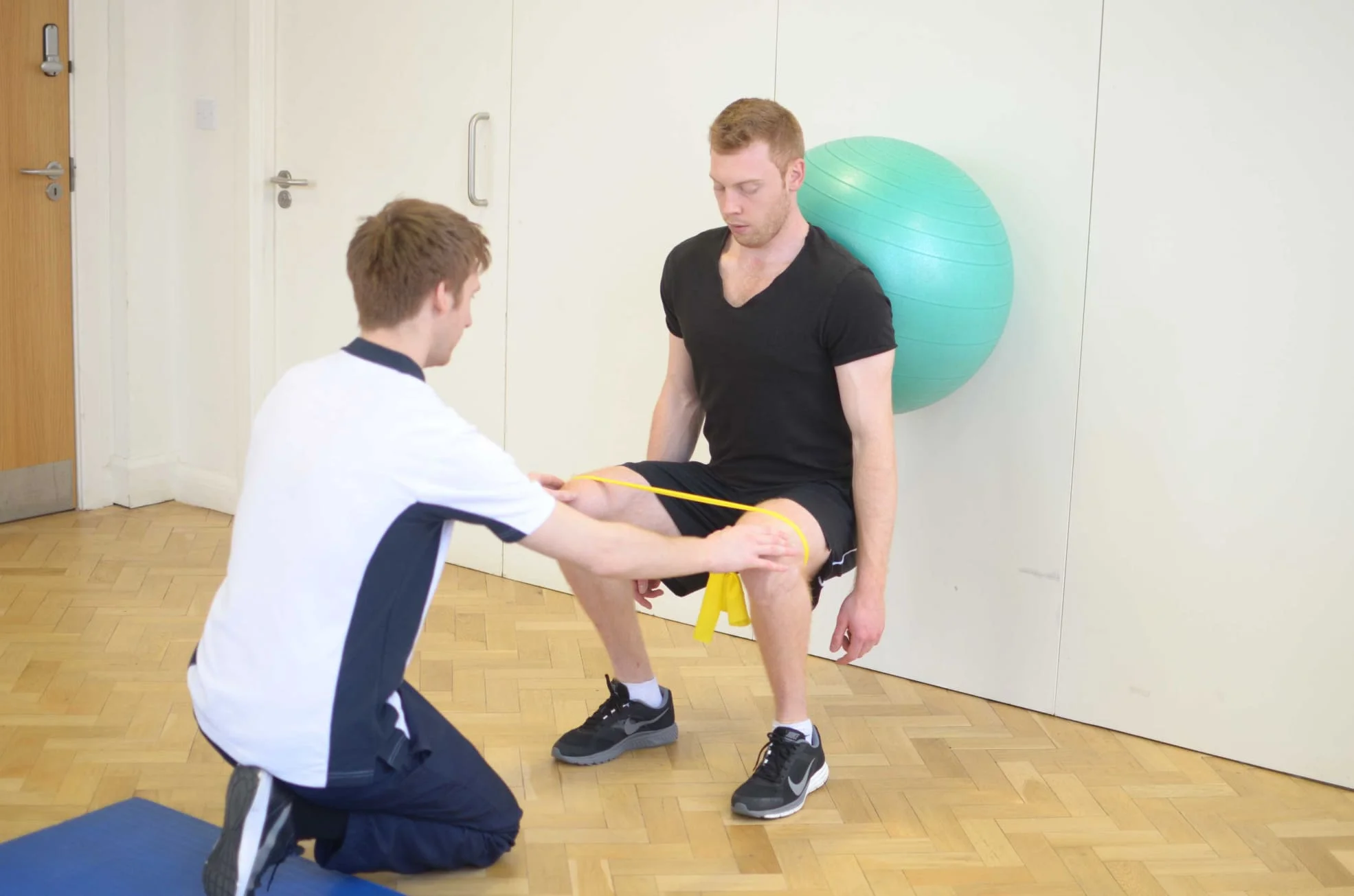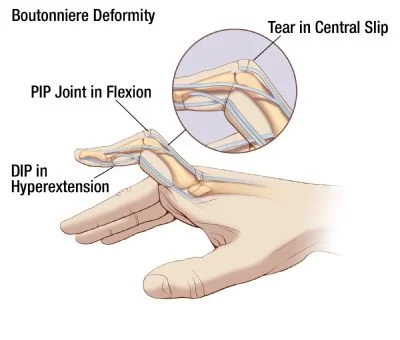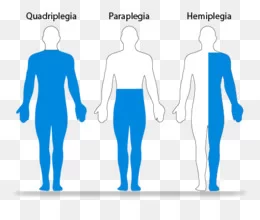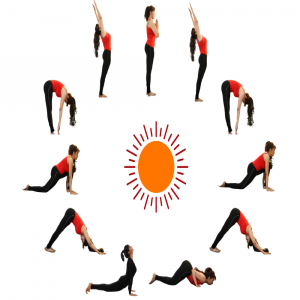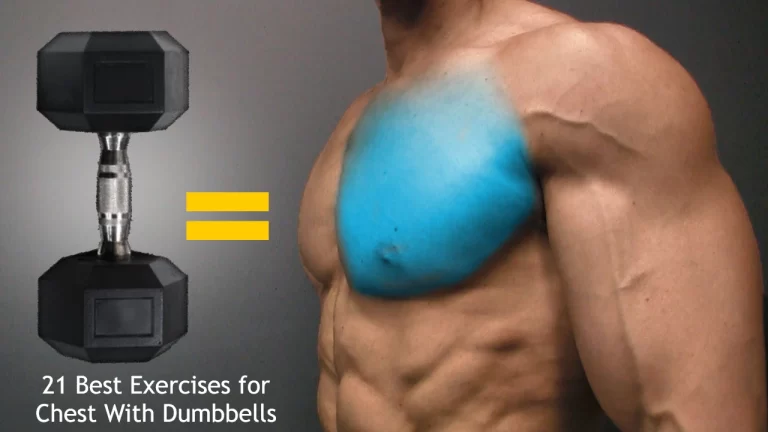Avulsion Of Hip Fracture Rehab Protocol
Importance of Avulsion Of Hip Fracture Rehab Protocol
Hip fractures are common injuries among the elderly, often resulting from falls or accidents. An avulsion hip fracture, specifically, refers to a type of injury where a small fragment of bone is pulled away from the main bone by a tendon or ligament. This injury can lead to significant pain, immobility, and loss of independence.
Rehabilitation after an avulsion hip fracture is crucial to restore mobility, function, and quality of life. The rehabilitation protocol aims to optimize recovery, prevent complications, and facilitate a safe return to daily activities. With a focus on multidisciplinary care, the rehabilitation program is tailored to the individual needs and capabilities of the patient, taking into account their overall health, pre-existing conditions, and specific fracture characteristics.
This protocol outlines the various stages of rehabilitation, including initial stabilization, pain management, mobility restoration, muscle strengthening, and functional training. Through a comprehensive approach that integrates physical therapy, occupational therapy, and medical management, this protocol aims to promote a successful recovery and enhance the patient’s overall well-being.
It is important for healthcare providers, caregivers, and patients to understand and adhere to this rehabilitation protocol to optimize outcomes and ensure a smooth transition back to an active and independent lifestyle. By following these guidelines, we can strive to minimize complications, reduce the risk of future injuries, and improve the overall prognosis for patients recovering from an avulsion hip fracture.
What Is A Hip Fracture?
A break in the upper portion of the femur (thigh) bone is known as a hip fracture. A ball-and-socket joint makes up the “hip.” It permits rotation and bending of the upper leg at the pelvis. The damage to the socket and the treatment of socket fractures require entirely distinct approaches. Multiple hip fractures are possible. Most of the time, The top portion of the femur is where the fracture happens.
Rarely, more than one kind of fracture can co-occur. For example, an acetabulum by itself is not regarded as a “hip fracture.”
- Transcervical (or Femoral Neck) Fracture: – a split located directly beneath the ball that slides into the socket on top of the femur. this kind of fracture may cause the joint’s blood supply to halt.
- Intertrochanteric Fracture: – a rupture through the femur’s upper portion.
- Subtrochanteric Fracture: – a rupture spanning the femur’s lengthy segment.
What Causes Hip Fractures?
Hip fractures are clearly caused by injury. An injury might arise from anything as simple as losing one’s balance and falling to the ground among the elderly population. While breaking the hip resulted in several hip fractures. The guy actually falls because of the hip fractures first. Bone loss is a condition that might weaken the femur’s neck to the point where any increased Stress can lead to an abrupt break in the femur’s neck.
It probably happened in this manner, and it’s true that the fall might have an Uncertain footing that can cause a twist in the hip joint, which puts excessive strain on the femur’s neck. The patient collapses to the floor after breaking their femoral neck. It happens so fast that the patient doesn’t know if the break or the fall happened first. There may be ties between several osteoporosis causes.
- Getting older
- Diet/lifestyle
- Genetics
- Drugs or other medical conditions
What Should You Expect After Surgery?
The goal of the majority of hip replacement surgeries is to have patients up and walking as soon as possible. Patients are typically seen by a physical or occupational therapist in the hospital shortly following surgery. During the day, you can be your chair or your bed.
You can start using crutches or a walker to move, practice clothing gain access to the restroom, and begin performing exercises to strengthen the muscles surrounding your hips and thighs and stop blood clots from forming. Depending on the type of surgery, a person’s ability to bear weight on the operated leg will vary. After surgery, the majority of patients are able to immediately resume full weight bearing. Following surgery, you might only be able to put some weight down, depending on how severe the fracture is.
The First 24-48 Hours:
- After a surgical procedure or injury, your physical therapist will assist you in Getting out of bed so that you can move about.
- Getting moving early can help avoid issues like blood clots.
- Following the surgeon’s or doctor’s instructions, learn how to use a walker or crutches carefully.
- To maintain the movement of the muscles throughout your entire lower leg, learn safe motions and exercises.
After the First 48 Hours:
- When a more intensive physical therapy program is appropriate for you will be determined by your physician.
- A physical therapy treatment program will be created to assist you whether you are receiving care at home, in a hospital, rehabilitation center, or outpatient clinic.
For Pain reduction. Several techniques may be employed by your physical therapist to manage and lessen your discomfort. They could consist of:
- Heat and ice.
- Mild electrical current stimulation.
- Affixing.
- Practises.
- Expert manual therapy methods.
Boost the motion:
- Your physical therapist will select particular exercises and therapies to assist in regaining your leg and hip’s natural range of motion.
- Your physical therapist may begin by using passive motions on your hip and leg joints. They will advance you to self-performed stretches and active activities.
Boost your strength:
- Every step of your recovery will benefit from specific exercises; your physical therapist will create a customized therapy plan, particularly for you.
- The exercises that will help you regain your strength, power, and agility will be selected and taught by them.
- These could consist of employing weights, aerobic machines, weighted pulleys, elastic bands, and weights.
Get back to your work:
- You and your physical therapist will work together to determine your rehabilitation objectives, which may include going back to work and playing sports.
- Your treatment plan will be created with your goals in mind, with the utmost safety, efficiency, and effectiveness.
- In addition to manual treatments, exercises, and work retraining activities, your physical therapist will employ equipment.
- If you want to play a sport, your physical therapist will work with you to develop your skills in sport-specific drills and techniques.
Avert further injuries:
- In order to assist you in avoiding more issues, your physical therapist will suggest a home exercise regimen that will help you stretch and strengthen the muscles in your upper leg, hip, and core.
- These could involve workouts and strength training.
- These exercises are crucial to lower the risk of falls, particularly in older persons, and will help with balance restoration.
Rehabilitation:
Following hip fracture surgery, rehabilitation is started as soon as possible often on the same day. The first objectives are to help patients avoid complications from bed rest and help them regain the level of strength they had prior to the fracture (by keeping them mobile and preventing loss of muscle tone). Restoring their ability to walk as well as they were able to is the ultimate goal.
People are encouraged to sit in a chair as soon as possible after surgery, often even within hours. Sitting makes the transition to standing easier and lowers the danger of blood clots and pressure sores. They are instructed to perform daily exercises to build stronger arm and trunk muscles, and occasionally they are instructed to perform exercises to build stronger big muscles in both legs.
A physiotherapist will examine you and give you advice on leg-building activities to help you get stronger. When you get home, it’s crucial to keep up these workouts because they support your recuperation and help strengthen particular muscle areas. On the first day following surgery, you will be helped out of bed and onto your chair. This aids in avoiding issues like chest infections or pressure sores from bed and enables you to resume regular activities more quickly.
Exercises involving ambulation, or walking, are initiated four to eight days following the injury if the patient is able to balance adequately and bear full weight on the affected leg without discomfort. Soon after walking is restarted, stair-climbing activities are initiated. One may receive instruction on the use of a cane or other assistance device, as well as fall prevention techniques.
Rehabilitation After Discharge:
Physical Therapy after Discharge:
- In the first six to nine months following surgery, many patients with hip fractures recover their gait and balance.
- During this time, the majority of patients are released from the hospital and live at home (with follow-up visits) or in nursing homes.
- Physical therapy during the subacute phase following surgery concentrates on promoting safe mobility and enhancing muscle function.
- Patients’ total mobility improved more after progressive resistance workouts than it did for the control groups.
- Exercises utilized in rehabilitation programs often include knee flexion/extension, lunge, leg press, hip abduction, balance, and lower-limb strength, with a focus on mobility relevant to activities of daily life.
Supervised Home-based Exercise Therapy:
- Program effectiveness for home-based exercise therapy under supervision is a critical concern in the treatment of hip fractures.
- When physical therapists came to the house, they explained to the family that following a hip fracture, rehabilitation had a significant favorable impact on physical functionality.
- The appropriate rehabilitative exercises for the patient.
Walking:
The proper use of walking assistance will be taught to you. The team will keep an eye on you and offer guidance while you’re in the hospital. If necessary, you might be moved up to crutches or sticks. That might occur after you get home. It is crucial that you get comfortable walking to and from the loo with the nurses. to return you as soon as possible to your regular daily schedule. You’ll get strength and confidence from this.
After the procedure, how much weight can I bear through my operated leg?
The specialist may determine that you should avoid bearing too much weight through the surgically repaired leg when standing or walking in order to safeguard your hip following the procedure.
The terms that carry weight below may be relevant,
- Non-Weight Bearing: The afflicted limb should not support any weight.
- Minimal weight bearing involves walking with a typical heel-toe gait while putting up to 25% of one’s weight through the afflicted leg.
- Walking as usual while putting up to 50% of your weight through the afflicted limb is known as partial weight bearing.
- Full Weight Bearing: Continue walking in the same manner, but put all of your weight through the injured limb.
Your physiotherapist will walk you through and demonstrate the proper weight-bearing position.
Stairs:
- If your home has stairs or steps, the physiotherapist will demonstrate the proper technique for climbing and descending.
- With one hand, hold the rail, and the other, your stick or crutch.
- Take it one step at a time when moving upstairs. Take the lead with the non-operated leg.
- Step one at a time when descending the stairs. Take the lead using the leg that underwent surgery.
The Advantages Of Exercise For Hip Fracture Rehabilitation:
Frequent exercise has the following benefits:
- The strength of my muscles has grown.
- Improves daily physical performance
- Better balance or posture
- Boost your blood flow
- Develop the muscles that surround your hip.
- Regain your hip’s mobility.
- Muscle atrophy
- Lessens pain and enhances mobility
- Boost adaptability
- Decrease any tightness or stress.
- Physical health has increased.
- Decreased likelihood of further harm or re-harm
- Your ability to tolerate pain throughout your favorite daily activities has improved.
What Physiotherapy Exercises Should I Perform To Help My Recovery?
Your physical therapist will create an exercise program to assist you in regaining movement and strength. You will learn and do your exercises at your physical therapy sessions, and you will continue them at home as needed. As your physical condition improves, you should modify your exercise routine.
The following exercises, as demonstrated by your physiotherapist, should be performed:
Deep Breathing Exercises
- Place your elbows slightly back while you sit or stand.
- This permits your chest to fully grow.
- Deeply inhale through your nose.
- Hold your breath and count to five.
- Exhale slowly and deeply through your nostrils until you feel the inhaled air has been expelled.
- Return to your neutral position after that.
- Then relax.
- Perform 5 to 10 repetitions.

Ankle Pump Exercises
- Sitting with your legs straight on the bed, or resting on your back with your legs straight on the bed.
- Briskly bend and straighten your ankles.
- Then return to your starting location.
- Then relax.
- 5 to 10 repetitions on each side.
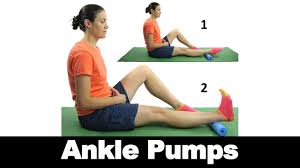
Straight Leg Raises Exercises
- Begin in a supine position on the table or the floor, relaxed.
- Bend one knee now.
- Then elevate your entire leg gradually.
- While maintaining a straight opposite knee.
- After that, hold for a few seconds.
- Lower your leg after that.
- Return to your neutral attitude gradually.
- Then take a break.
- Repeat on the other side.

Quad Sets Exercises
- Stretch your damaged leg out in front of you while seated on the floor.
- Tighten the muscles on top of your thigh by putting your knee flat on the floor.
- Maintain this posture for a few seconds.
- Return to your neutral position after that.
- Then relax.
- Perform 5 to 10 repetitions.
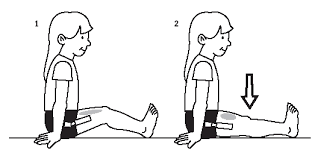
Buttock Squeezes Exercises
- Straighten your legs and lie flat on your back.
- Squeeze together your buttocks.
- Hold for a total of five seconds.
- Then take a five-second break.
- Return to your neutral position after that.
- Then relax.
- Perform 5 to 10 repetitions.
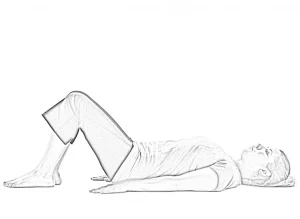
Heel Slides Exercises
- Begin in a calm supine position on a bed or table.
- Bend your knees and move your affected leg towards your buttocks.
- putting your heels up against your buttocks.
- Touch until you find a comfortable position.
- Keep it there for a few seconds.
- Return to your neutral position by softly straightening your leg.
- Then unwind.
- Repeat on the opposite side.
- Repeat on each side 5-10 times.
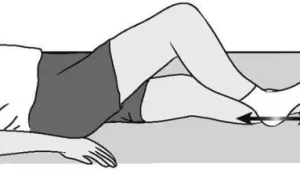
Short Arc Quads Exercises
- Sleep down on your back.
- To support your knee, use a yoga block or a basketball.
- Straighten your bowed knee slowly until it is straight.
- Tighten your quadriceps muscle while pointing your toes towards the ceiling.
- Hold it in place for five seconds.
- Lower your leg gradually.
- Slowly return to your neutral stance.
- Then unwind.
- Repeat on the opposite side.
- Repeat on each side 5-10 times.

Side Lying Leg Lifts Exercises
- Stack your hips and lie on your side.
- Fold your floor-side arm beneath your head to support your head.
- To remind yourself not to lean forward or backward, place your upper hand on the floor in front of you.
- Stack both feet and flex them.
- Raise your top leg slightly over your hip until you feel your hip flex.
- Hold it in place for five seconds.
- Lower your leg gradually.
- Slowly return to your neutral stance.
- Then unwind.
- Repeat on the opposite side.
- Repeat on each side 5-10 times.
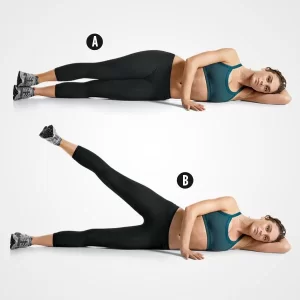
Hip Flexion (standing) Exercises
- Place your feet shoulder-width apart.
- For support, grasp a stable chair or table.
- To protect your back, perform an abdominal draw-in.
- Pull your umbilicus (belly button) in towards your back to accomplish this.
- Maintain a straight knee and pointed toes as you kick your leg forward in a slow and controlled motion.
- Return to your starting point.
- Then unwind.
- Rep with the opposite leg.
- Rep 5-10 times per day.
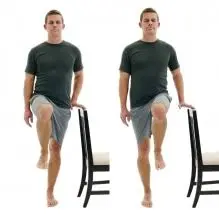
Clamshell Exercises
- Begin by sitting comfortably on one side of the table.
- Cinch your stomach.
- Now, bend your knees.
- Raise your upper leg, keeping your feet together.
- Hold on for a moment.
- Then slowly lower your leg.
- Return to your neutral position after that.
- Then relax.
- 5 to 10 repetitions on each side.
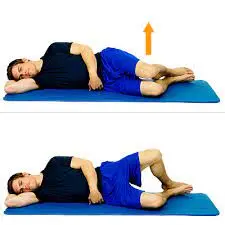
Single Leg Bridging Exercises
- Your abs and buttocks must support you as you raise your hips until your shoulders and knees are in a straight line.
- Tighten your abdominal muscles simultaneously, as though you were attempting to pull your belly button back towards your spine.
- Maintain this position for a short while.
- Lower your hips cautiously to the floor while keeping your leg extended to return to the starting position.
- Return to your neutral position after that.
- Then unwind.
- With the other leg, perform the same exercise.
- Five to ten times over.

Hip Flexion (sitting) Exercises
- To begin, take a chair upright and place your feet flat on the ground.
- Raise your right leg slightly to start marching on the spot.
- Then go back to where you started.
- Then relax.
- For each side, perform five to ten repetitions.
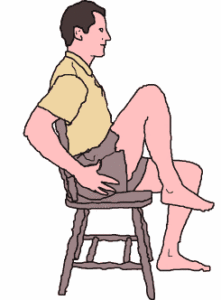
Hip Abduction Exercises
- Adopt a straight posture with your feet, knees, and hips pointing forward.
- For a short while, raise and hold your left leg out to the side.
- Subsequently, return to your neutral stance gradually.
- Then relax.
- Ten or more times over.
- Flip over the opposite side.
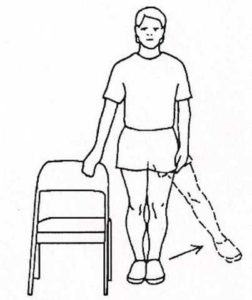
Hip Extensions Exercises
- Seize hold of anything at waist height, such as the back of a chair.
- Keep your back straight and hold while extending one leg out from behind you.
- Subsequently, return to your neutral stance gradually.
- Then relax.
- Ten or more times over.
- Flip over the opposite side.
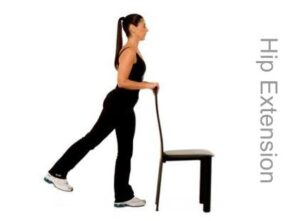
Sit To Standing Exercises
- Sit up straight in a chair to begin.
- Sit closer to the chair’s edge by pushing your posterior forward.
- Place your feet flat on the ground.
- As you stand, move your operated leg forward and maintain it out in front of you.
- Using your arms, firmly grasp the chair’s arms and raise yourself up.
- Subsequently, return to your neutral stance gradually.
- Then relax.
- Ten or more times over.
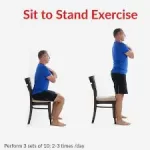
Knee Straightening: Sitting Exercises
- Begin by sitting upright in a chair, feet flat on the floor.
- Lift your foot off the floor with your toes pointing to the ceiling.
- Straighten your knee and tense your muscles for five seconds.
- Return to your neutral position after that.
- Then relax.
- 5 to 10 repetitions on each side.
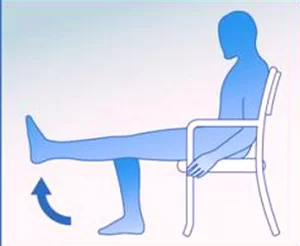
Butterfly Stretch
- Having your feet pressed together, take a seat on the ground or on a prop.
- Bring your feet in closer to your hips to intensify the feeling.
- Dig into your sitting bones and legs.
- Tuck your chin in towards your chest while lengthening and straightening your spine.
- Feel the energy flowing out through the top of your head and lengthen your spine with each breath.
- Sink down further into the stretch or fall heavily to the floor with each exhalation.
- For as long as two minutes, maintain this posture.
- Subsequently, return to your neutral stance gradually.
- Then relax.
- Ten or more times over.

Heel Raise Exercises
- Hold onto or lean against a sturdy surface while standing, like the back of a hard chair or the kitchen counter.
- Elevate your heels off the ground by pushing up onto your toes with both legs.
- Don’t bend your knees.
- For five seconds, hold on.
- Then descend once more.
- Subsequently, return to your neutral stance gradually.
- Then relax.
- Ten or more times over.
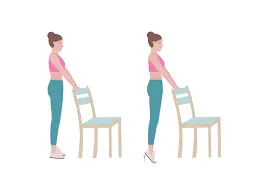
Psoas Hold Exercises
- Bend your right knee and raise your upper leg towards the sky while you are standing.
- Maintaining your right knee and thigh at hip level, you balance on your left foot.
- For five seconds, hold on.
- Slowly stoop your right leg.
- Subsequently, return to your neutral stance gradually.
- Then relax.
- Repeat with your left leg after that.
- Ten or more times over.
- Do not forget to maintain a tall trunk during the entire exercise.
- Don’t raise your leg as high if your head is cocked forward if your trunk is rounded.
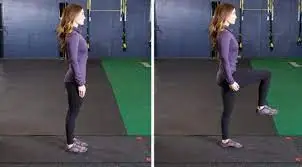
Hip Abduction(sitting) Exercises
- Taking a seat, turn to face the sideways.
- Enter a resistance hip band with both feet and draw it around your lower thighs.
- Place your feet slightly wider than hip-distance apart and point your toes outward. Maintain a knee-over-toe position.
- As you pull your knees apart, you should feel the band’s resistance.
- Keep your feet firmly planted on the ground, but let them slant slightly outward.
- Hold for a short while after that.
- After which go back to your neutral posture.
- Then unwind.
- Five to ten times a day, repeat.
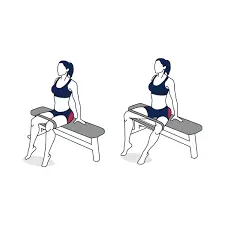
Half-Kneeling Hip Flexor Stretch
- Having your right knee on the ground behind you and your left foot flat in front of you, drop to your knees on the ground.
- Try to maintain a tall trunk during this workout.
- For balance, you can continue to rest your hands on your left knee.
- Slide your right knee back slowly until the front of your hip stretches slightly.
- Bring your hips and trunk towards your left foot by contracting your right glute as though you were pushing forward.
- In order to create a pelvic tilt, tuck your hips gently.
- Breathe deeply, then hold this position for ten to thirty seconds.
- Subsequently, return to your neutral stance gradually.
- Then relax.
- Ten or more times over.

Trunk Rotation
- Upon an exercise mat, begin in the supine position (lying on your back).
- Maintain a bent knee and flat feet on the ground.
- Keep your upper body and shoulders firmly planted on the ground.
- To improve your balance while performing the exercise, extend your arms and firmly plant them on the ground.
- Tighten or contract your abdominal muscles.
- Within your range of motion, slowly and deliberately rotate your knees to one side.
- Although they’ll move, your feet will remain on the earth.
- For three to five seconds, hold the position.
- To transfer your legs to the opposite side, contract or engage your abdominal muscles.
- Hold for a further 3-5 seconds.
- During the workout, maintain your attention and breathe normally.
- For a certain number of repetitions, say ten on each side, repeat the exercise.
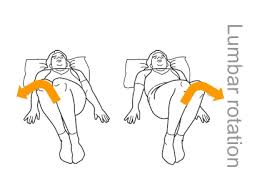
Which Safety Measures Must Be Taken When Exercising?
- Maintaining good posture is crucial when exercising.
- Don’t engage in strenuous exercise.
- Warm up fully before beginning any exercise.
- If you have an acute ache while exercising, stop.
- Get the Proper Balance
- Remain hydrated.
When Do You Break Over On Exercise?
- Severe aches in the muscles
- You spread with ease.
- If there is pain or numbness.
- The fever and headache workout should be stopped if it hurts.
What Kind Of Activity Should You Avoid Doing If You Have A Hip Fracture?
- You are recommended to avoid all high-impact activities.
- You should also avoid twisting, bending, or lifting.
- That being said, this does not mean that you should do nothing till the break mends.
- So as to give the bone time to recover, such as through sports and exercise.
Conclusion:
Hip fracture patients may benefit from postoperative rehabilitation in terms of their quality of life and postoperative clinical outcomes, but there is not enough information available due to the variety of research methodologies and variations in published study results. to unequivocally validate this possible advantage. An orthopedic surgeon must strongly support patient-specific rehabilitative strategies and be aware of the advantages and disadvantages of various solutions.
FAQs
How much time does hip fracture recovery take?
To get back on their feet following a hip fracture, however, the majority of patients will require intense rehabilitation therapy for at least 4 to 6 weeks. Healing and rehabilitation may require replacement procedures in some situations. several months, usually three to six whether there is a partial or complete joint
What part does physical therapy play in hip fractures?
In order to promote the swift advancement of mobility and restore the patient’s pre-illness mobility condition, frequent, intense physical treatment is required. Unfortunately, a lot of patients never fully regain their prior degree of independence or movement, and as a result need social care assistance.
What amount of time does it take to be able to walk properly again after hip surgery?
Most hip fracture victims are unable to walk or stand. Walking would sometimes be possible, but it would be quite taxing on the leg. Physical alterations: Your hip can be bruised. You can have one leg that seems shorter than the other.
What amount of time does it take to walk normally after hip surgery?
After a hip replacement, you can walk right away, but you still need to use caution. Each patient’s total hip replacement recovery period and process is unique, ranging from two weeks to a year for complete recovery.
After a hip fracture, when should I begin physical therapy?
If your surgery is on the weekend, your rehabilitation with the physiotherapist will start the day after, with the use of suitable mobility assistance. To ensure that you can move comfortably, it’s critical that you take pain medication on a regular basis.
How should someone deal with a hip injury?
Steer clear of bending down and applying pressure on your hips repeatedly. Avoid sleeping on the afflicted side and avoid prolonged sitting.
What is the quickest way for a hip fracture to heal?
Stretches for the hamstrings and leg lifts, for example, can keep muscles from stiffening up or weakening while you keep your weight off your broken hip. A fracture may heal more quickly with physical therapy than with immobilization alone.
How might a hip fracture cause one to lose their mobility?
The evidence indicates that mobility-focused exercises when added to conventional care, can help patients recover safely from hip fracture surgery and resume walking and movement. This effect is shown both during hospital stays and after release.
What should and shouldn’t be done following hip surgery?
Avoid bending your hips more than ninety degrees, sitting on low-backed or oversized couches and chairs, bucket seat cars, and picking up objects from the floor by using a grasping device. Avoid crossing your legs. Wait to get permission to drive an automobile before you
your physician. Never lift anything heavy.
Which three hip precautions are there?
Patients are advised to refrain from crossing their legs, twisting their legs in or out, and bending their hips past 90 degrees. In addition, patients should sleep on their backs with pillows between their legs, sit in a chair with armrests, and elevate their hips above their knees.
Which is better for hip pain: resting or exercising?
While sleeping is beneficial during the acute stage of your illness, sleeping too much can make your pain and stiffness worse. There are particular exercises that can assist in strengthening and stretching your hip joint without being too taxing on your body. Several of these Among the crucial exercises is the donkey kick.
Can a hip break be treated at home?
The hips can be strengthened and their range of motion improved using a number of workouts. A few at-home workouts to help you or a loved one get back on your feet are included below. After warming up, it’s crucial to stretch. Extend your limbs throughout your body, not just your hips.
Does cycling help with hip strength?
Cycling maintains hip mobility, which enhances hip function generally and enhances sports performance. It works the muscles in your back, legs, and hips in addition to toning your abdominal muscles.
What occurs if following hip surgery physical treatment is skipped?
A patient may never fully regain range of motion without physical therapy and exercise. Perhaps for this reason more than any other, you should see your therapist during the post-operative recovery phase of your procedure. It will ultimately be worthwhile, even though it may be challenging and uncomfortable.
Which workouts build hip strength?
Quad Sets
Buttock Squeezes
Side Lying Leg Lifts
Clamshell
Straight Leg Raises
Psoas hold
Which goals does physical therapy have for hip rehabilitation?
Restore the hip joint’s strength and range of motion.
Avoid problems from extended bed rest.
A safe and gradual return to normal daily movement.
What not to do having a fractured hip?
Preventive actions are required for a few months (often one to three months) following discharge. In order to strengthen the muscles in the affected leg and torso, people should engage in daily activity. It is advised that they avoid stooping, reaching, jumping, lifting, or pushing big objects, as well as spending extended amounts of time in chairs.
What should people do if they break their hip?
Hip fractures are often treated with a combination of early surgical repair, physical therapy, and pain medication to control swelling, stop blood clots from forming, and avoid infection.
What eases hip discomfort?
Applying ice to the affected area for around 15 minutes many times a day is another method of treating hip pain. Until you feel better, try to rest the afflicted joint as much as you can. You might also try heating the area. To prepare your muscles for pain-relieving stretching activities, take a warm bath or shower.
What causes hip fractures most frequently?
People 65 years of age and older typically suffer hip fractures, which are typically brought on by falls. Your bones gradually weaken with age and become more prone to breaking, even from small falls. Hip fractures in children and young adults are more common as a result of sports injuries, automobile accidents, and bicycle accidents.
What is the duration of hip swelling?
Consider substantial to severe swelling in the weeks following surgery. You may also experience mild to moderate swelling for 3 to 6 months following surgery. Elevate your leg slightly and apply ice to minimize swelling. Wearing compression stockings may also aid in the reduction of swelling.
References
- Portugal, S. E. 2023, October 13. Rehabilitation After a Hip Fracture. MSD Manual Consumer Version. https://www.msdmanuals.com/enin/home/fundamentals/rehabilitation/rehabilitation-after-a-hip-fracture. In-Text Citation: (Portugal, 2023)
- Lee, K.-J., Um, S.-H., & Kim, Y. 2020, January 1. Post-operative Rehabilitation after Hip Fracture: A Literature Review. Hip and Pelvis. https://doi.org/10.5371/hp.2020.32.3.125. In-Text Citation: (Lee, Um, & Kim, 2020)
- Guide | Physical Therapy Guide to Femur Fracture. 2020, June 14. Choose PT. https://www.choosept.com/guide/physical-therapy-guide-femur-fracture. (“Guide | Physical Therapy Guide to Femur Fracture,” 2020) In-Text Citation:
- Exercise, Dpt, K. G. P. 2023, September 18. Walking and Physical Therapy Exercises Following a Femur Fracture Verywell Health. https://www.verywellhealth.com/broken-femur-exercises-and-physical-therapy-5224410. In-Text Citation: (Dpt, 2023)
- Exercise, ( “Hip exercises (sitting exercises) complying with hip fracture surgery,” at the time) hip-exercises-sitting.htm or visit https://www.uhb.nhs.uk/services/trauma-and-orthopaedics/hip-fracture-surgery.htm. ( “Hip movements adhering to a hip fracture procedure (sitting as exercises),” at the moment of the incidence)
- IMAGE, Fitness, R. 2020, December 10. 10 simple workouts to strengthen your glutes and prevent soreness! RedBox Fitness. https://www.redboxfitness.com/glutes-injury-prevention/. In-Text Citation: (Fitness, 2020)
- IMAGE, Facebook. n.d. . https://www.facebook.com/SkrehotMassageTherapy/posts/wall-psoas-holdthis-move-strengthens-your-deep-hip-flexor-muscle-known-as-the-ps/2050902388537198/. In-Text Citation: (“Facebook,” n.d.)

